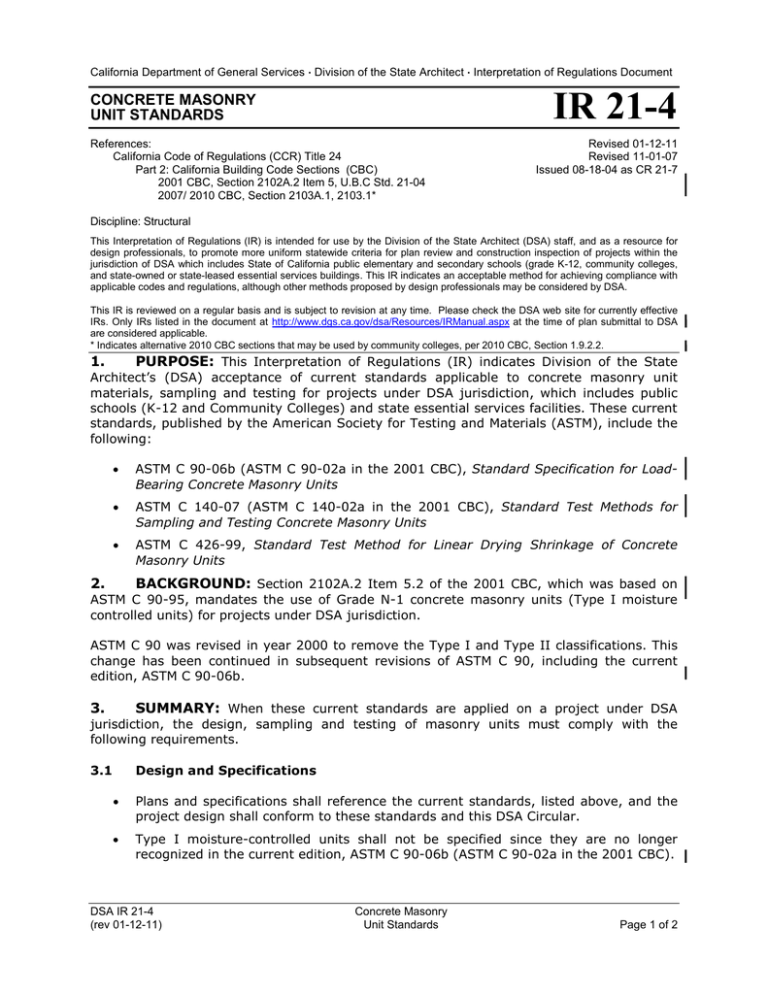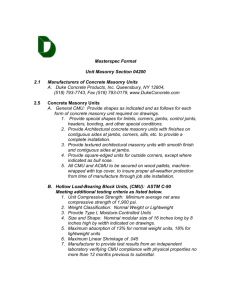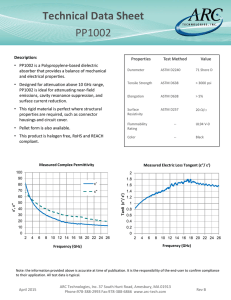DSA IR 21-4: CONCRETE MASONRY UNIT STANDARDS
advertisement

California Department of General Services . Division of the State Architect . Interpretation of Regulations Document IR 21-4 CONCRETE MASONRY UNIT STANDARDS References: California Code of Regulations (CCR) Title 24 Part 2: California Building Code Sections (CBC) 2001 CBC, Section 2102A.2 Item 5, U.B.C Std. 21-04 2007/ 2010 CBC, Section 2103A.1, 2103.1* Revised 01-12-11 Revised 11-01-07 Issued 08-18-04 as CR 21-7 Discipline: Structural This Interpretation of Regulations (IR) is intended for use by the Division of the State Architect (DSA) staff, and as a resource for design professionals, to promote more uniform statewide criteria for plan review and construction inspection of projects within the jurisdiction of DSA which includes State of California public elementary and secondary schools (grade K-12, community colleges, and state-owned or state-leased essential services buildings. This IR indicates an acceptable method for achieving compliance with applicable codes and regulations, although other methods proposed by design professionals may be considered by DSA. This IR is reviewed on a regular basis and is subject to revision at any time. Please check the DSA web site for currently effective IRs. Only IRs listed in the document at http://www.dgs.ca.gov/dsa/Resources/IRManual.aspx at the time of plan submittal to DSA are considered applicable. * Indicates alternative 2010 CBC sections that may be used by community colleges, per 2010 CBC, Section 1.9.2.2. 1. PURPOSE: This Interpretation of Regulations (IR) indicates Division of the State Architect’s (DSA) acceptance of current standards applicable to concrete masonry unit materials, sampling and testing for projects under DSA jurisdiction, which includes public schools (K-12 and Community Colleges) and state essential services facilities. These current standards, published by the American Society for Testing and Materials (ASTM), include the following: • ASTM C 90-06b (ASTM C 90-02a in the 2001 CBC), Standard Specification for LoadBearing Concrete Masonry Units • ASTM C 140-07 (ASTM C 140-02a in the 2001 CBC), Standard Test Methods for Sampling and Testing Concrete Masonry Units • ASTM C 426-99, Standard Test Method for Linear Drying Shrinkage of Concrete Masonry Units 2. BACKGROUND: Section 2102A.2 Item 5.2 of the 2001 CBC, which was based on ASTM C 90-95, mandates the use of Grade N-1 concrete masonry units (Type I moisture controlled units) for projects under DSA jurisdiction. ASTM C 90 was revised in year 2000 to remove the Type I and Type II classifications. This change has been continued in subsequent revisions of ASTM C 90, including the current edition, ASTM C 90-06b. 3. SUMMARY: When these current standards are applied on a project under DSA jurisdiction, the design, sampling and testing of masonry units must comply with the following requirements. 3.1 Design and Specifications • Plans and specifications shall reference the current standards, listed above, and the project design shall conform to these standards and this DSA Circular. • Type I moisture-controlled units shall not be specified since they are no longer recognized in the current edition, ASTM C 90-06b (ASTM C 90-02a in the 2001 CBC). DSA IR 21-4 (rev 01-12-11) Concrete Masonry Unit Standards Page 1 of 2 DSA IR 21-4 (rev 01-12-11) Concrete Masonry Unit Standards Page 2 of 2 • Grade N units shall not be specified since they are no longer recognized in the 2007 or 2010 California Building Code. • Control joints should be specified at a maximum of 25 feet spacing, in accordance with the National Concrete Masonry Association (NCMA) TEK 10-01A, “Crack Control in Concrete Masonry Walls.” Alternatively, refer to Section 3.2.2, below. 3.2 Sampling and Testing Of Concrete Masonry Units The owner’s material testing laboratory must be currently accepted by DSA’s Laboratory Acceptance Program (LEA). The owner’s laboratory shall sample masonry units in accordance with ASTM C 90 Section 4 and perform the following tests: 3.2.1 3.2.2 Mandatory Tests • Measurements (Section 5, ASTM C 140) • Compressive strength (Section 6, ASTM C 140) • Absorption (Section 8, ASTM C 140) Shrinkage Testing of Concrete Masonry Units Per ASTM C 90, Sections 5.2 and 8.3, manufacturers are required to conduct regular quality control testing to ensure that units delivered to projects will meet the linear shrinkage requirement (0.065 percent maximum). DSA will not require project-specific linear shrinkage testing if control joints are specified at 25 feet maximum spacing, otherwise testing is required. Additionally, the project design professional may require linear shrinkage testing for special design or construction conditions. When testing is required, the owner’s material testing laboratory shall conduct linear shrinkage testing in accordance with ASTM C 426. Test data shall be traceable to the units being supplied for the project, and shall comply with ASTM C 90, Section 8.3. 3.2.3 Reporting Test reports conforming to Section 10 of ASTM C 140 and 2001/2007 Title 24, Part 1 Section 4-335(d) (Section 4-335(g) of the 2010 Part 1) shall be submitted to the project design professionals, the project inspector, the owner, and DSA.


